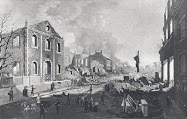Tony Lo Bianco, ‘French Connection’ Actor, Dies at 87
Once
labeled a “natural-born heavy,” he shined onscreen and especially
onstage, securing a Tony nomination and winning an Obie Award.
Tony Lo Bianco, an actor whose film roles included villains in “The French Connection” and “The Honeymoon Killers” and whose stage career earned him stellar reviews for an Arthur Miller tragedy and an Obie Award for a baseball drama, died on Tuesday at his home in Poolesville, Md. He was 87.
The cause was prostate cancer, his wife, Alyse Lo Bianco, said.
Mr. Lo Bianco made a vivid impression in “The Honeymoon Killers” (1970), a low-budget black-and-white film, based on a true story, that came to be regarded as a cult classic. With a heavy Spanish accent and serious sideburns, he played Raymond Fernandez, a con man who courted, married and murdered lonely women for their bank accounts, passing off his real lover (Shirley Stoler) as his sister. The Guardian called the film the movies’ first “super-realist depiction of the banality of evil.”

A United Press International writer once labeled Mr. Lo Bianco “a natural-born heavy” because of his dark hair, bushy eyebrows and sharp features. In “The French Connection” (1971), moviegoers saw him as the owner of a modest Brooklyn diner, Sal and Angie’s, dressed to the nines and driving a car with European plates, courtesy of international drug money. In “The Seven-Ups” (1973), he was a mortician at one of the Mafia’s favorite funeral homes.
But Mr. Lo Bianco was a stage actor at heart. He won an Obie Award in 1975 for “Yanks 3, Detroit 0, Top of the Seventh,” in which he played Duke Bronkowski, a baseball player with age and time breathing down his neck who is trying to pitch a perfect game during his 14th season in the major leagues.
In 1983, Mr. Lo Bianco triumphed on Broadway in Arthur Miller’s “A View From the Bridge” as a Brooklyn longshoreman destroyed by his obsession with his 17-year-old niece. The performance brought him a Tony Award nomination for best actor in a play.
Frank Rich, in his New York Times review, called it a “tumultuous star performance” and described Mr. Lo Bianco as “such a dynamic and enveloping force” that the audience never questions the play’s action. He “looms up,” Mr. Rich wrote, “to make the theater shake.”
Mr. Lo Bianco’s success stemmed in part from previous experience with the role, which he had played in summer stock in the 1960s. “I knew 20 years ago this would happen,” he said of the play’s reception. “It doesn’t surprise me at all. I knew the power of this play.”

Anthony Lo Bianco was born in Brooklyn on Oct. 19, 1936. His parents — Carmelo Lo Bianco, a taxi driver, and Sally (Blando) Lo Bianco — were first-generation Italian Americans. Anthony attended a vocational high school, where a speech and drama teacher suggested that he study acting.
Read the rest of Mr. Lo Bianco's obituary here:
https://www.nytimes.com/2024/06/12/movies/tony-lo-bianco-dead.html











